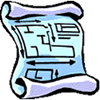

Chapter
14 Review
B. Problems
Use the periodic table to solve the following problems. Each letter represents
a single element.
1. Three elements are represented by the letters A, B, and C. The three
elements have the same number of valence electrons. Element C has electrons
in three energy levels and element A is the lightest of the three. Element
B has a total of twenty electrons. Identify the elements.
2. Four elements are represented by the letters J, K, L, and M. The four elements are all active metals and have the same number of valence electrons and a filled valence subshell. Element J is the most metallic and has electrons in flue energy levels. Element M has a larger atomic radius than either K or L but is smaller than J. L has a higher first ionization energy than does K. Identify the elements.
Essay Question
3. What is the change in metallic properties of the elements in group 1 with increasing atomic number? How is this change related to the change in electronic and nuclear structure of the atom?
Use the periodic table given to solve the following problems. Each letter represents a single element.
4. The particles U, V, W, X, and Y all have three shells of electrons and the same number of electrons. They are listed in order of decreasing size. The only neutral atom is W U reacts with Y to form the compound YU and with X to form the compound X2U. Identify the elements.
5. Phosphorous atoms may share electrons with chlorine atoms, with fluorine atoms, or with oxygen atoms. Use the electronegativity values for P (2.1), CI (3.0), F (4.0), and O (3.5) to rank the P-Cl, P-F, and P-0 bonds in order of decreasing attraction of the electrons for the phosphorus atom.